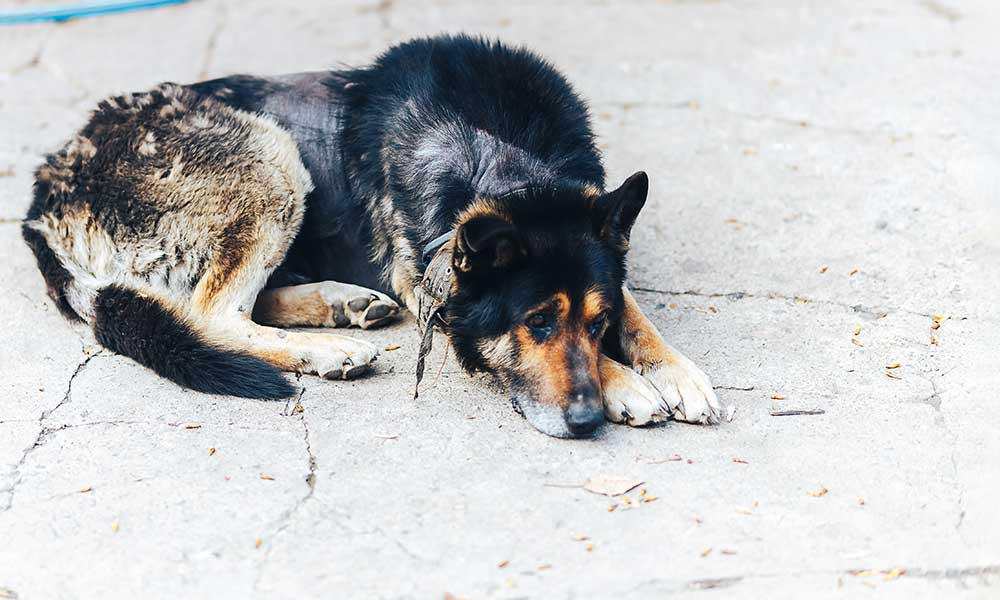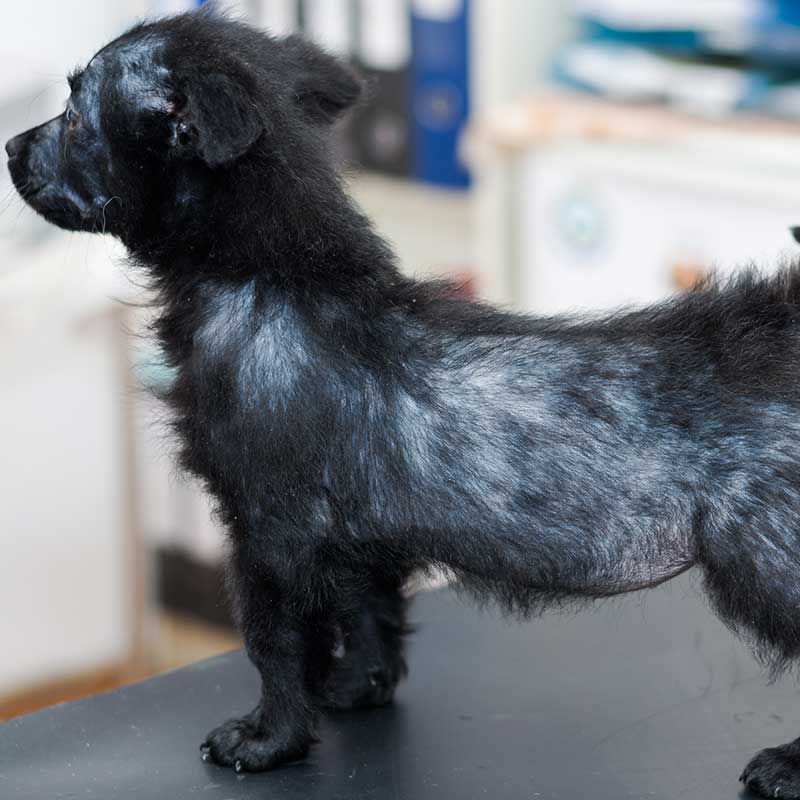Hair loss in dogs is a relatively common occurrence. Living with a pet means that you will experience hair stuck to every surface of your home on a daily basis. The shedding of hair is never to be worried about, but rather the sudden increase in hair loss or bald spots appearing on your dog. The issue is identifying the cause of extreme hair loss. The reason for a dog’s sudden Alopecia (hair loss) can range from genetics, to disease, to foreign objects. The severity of hair loss in dogs can differ as well. Many factors can come into play when it comes to its causes. In this article, we will explore those causes. This article is simply a guide and if you notice sudden or extreme hair loss in your dog you should schedule a vet visit immediately. Due to the many causes, it’s impossible to determine without the expertise of a vet and the tests necessary to deduce a diagnosis.
What Causes Hair Loss in Dogs?

We recommended seeing a vet to determine the cause of your pet’s hair loss because, well, it can stem from a slew of causes. The causes of your dog losing hair can be benign in their severity to needing special attention and, in some cases, medication to combat. Below we will answer the question of “why is my dog losing hair”, by listing the causes in the order of severity. Ranging from the least severe to the most. Again, if you notice your dog losing hair you should consult a veterinarian immediately for a conclusive diagnosis.
Genetics
At the end of the day, the easiest explanation is often the right one. We’re pet parents and when we see that our fur-baby is suffering or going through ‘something’ that contradicts the norm, we usually expect the worse. Sometimes, the worst is not the case at all. There are specific breeds of dogs that are more prone to hair loss than others. Developing bald spots could very well be a hereditary condition that you have no control over. You can never fight genes or science and sometimes our dog’s hair just falls out. Breeds like Chihuahuas, Dachshunds, Greyhounds and Whippets are among the more common breeds to experience hair loss.
Foreign Objects
We refer to our pets as our babies, fur-babies or children because that’s basically what they are. Dogs don’t ask permission before they do something. Dogs don’t check to make sure something is safe before they sniff it or play with it. Because of that, it’s very common for them to get some type of foreign object under their skin. Thorns, glass, garbage, anything can find a way to irritate your pet’s skin if it breaks it. If you’ve ever had an ingrown hair then you know that it’s very easy to have the skin irritated and dogs have a lot of hair. Dogs are no different. If your pet has something under their skin, you’ll notice that there is a constant licking or nipping at a specific area. Check the area to see if there is any redness or irritation, but you’ll likely have to visit the vet if there is something that needs to be removed.
Ticks
Ticks are one of the few ailments that you can identify without the consultation of a veterinarian. Ticks are usually more common in heavily wooded areas and where one tick is found, many more are likely nearby. Ticks can be a relatively dangerous affliction for your pooch as they can release toxins into their bloodstream. While you may not need a vet to identify a tick, you probably need one to help remove it or treat it. Only the most hardcore of dog owners likely have a “tick tool” on hand for such occasions. Due to the discomfort of ticks, you may notice your dog excessively scratching or biting at an area, leading to hair loss in you dog.
Anxiety/Constant Licking
Sometimes alopecia in dogs can be caused by stress or anxiety. Most dogs develop a form of anxiety or stress in their later years. Maybe you live in a noisy neighborhood, often entertain guests or you have recently moved/changed the environment your pet is used to. While these issues may seem small to you, they could be world changing for your dog. Many times, bringing in a new dog or cat can lead to the older pet developing canine anxiety or depression and obsessively licking a spot on their body. Most commonly their legs. This type of alopecia usually doesn’t require a vet visit unless you’re interested in medication. CBD has proven itself to help with pet anxiety and often reduce the symptoms of stress. Before you put them on medication, consider the CBD alternative to clear up any bald spots your pet may be developing due to anxiety.
Ringworm
Ringworm is an infection that often affects the skin, hair and nails of dogs. Like ticks, dogs can contract ringworms from direct contact with foreign objects. In the case of ringworm, it is spread through direct contact with certain fungi. Contaminated objects can range from their food dish, bedding, couch, carpet, outdoor furniture and the list goes on. It presents itself in round patches of hair loss. As the fungus spreads, the size of the hair loss patch will grow with it and usually go from a circle pattern to more irregular shapes. The patches of skin can become red, irritated and scab at times, but usually aren’t itchy or overly painful. Treating ringworm is relatively simple. You will want them separated from contact with other people and dogs, to stave off the spread, and introduce topical medications like lotions, shampoos and so on. A vet visit is highly recommended when you notice the symptoms of ringworm developing in your pet.
Pyotraumatic/Moist Dermatitis
Also referred to as “Hot Spots”, this irritation often presents itself as a red, irritated and sometimes oozing spot on your pet’s skin. Hot spots are known to be very uncomfortable and can be quite painful. A vet visit should be immediate to reduce the pain your pooch is suffering through and they will also prescribe a topical treatment to disinfect and heal the infected area. A cone may be recommended to reduce excessive licking and allowing the topical Moist Dermatitis treatment to run its course and clean the affected area.
Hyperthyroidism
More common in medium to large dogs in their middle-age to twilight years. Hyperthyroidism is a disorder that affects the thyroid gland’s production of the hormone “thyroxine”, which controls metabolism. While hair loss in dogs is a common side-effect of this ailment, it’s only one in a list of symptoms your pet may exude. Weight gain, lethargy, dull and thin coat mixed with dry-flaky skin are the telltale signs of Hyperthyroidism. In more severe cases, pets can develop black patches on the skin and a lowered heart rate. Hyperthyroidism isn’t life threatening, but treating it will help to improve your pet’s quality of life.
Cushing’s Disease
Also known as Hyperadrenocorticism (that’s a lot to say) Cushing’s disease is one of those hereditary ailments that could lead to hair loss in dogs. CD is caused by the body overproducing the cortisol steroid hormone. Often, CD develops in middle-aged and older dogs. Hair loss is just one symptom of this ailment and presents itself alongside weight gain, more skin issues, abdominal swelling and lethargy. Cushing’s disease, sometimes, requires no treatment at all due to the risks that accompany it, but if you suspect your dog may be suffering from CD, schedule a vet visit immediately.
Cancer Treatment
Alopecia in dogs is to be expected when they are going through cancer treatment. A vet should inform you of that possibility before starting treatment, but the signs of hair loss in your dog can be jarring to most. Cancer is a serious disease and treatments like chemo often lead to patches of hair loss or complete hair loss depending on the length of the treatment.
Conclusion

Wondering why your dog is losing their hair can almost cause you to lose some hair by worrying. Hair loss in dogs, aside from old age, is usually a sign of distress, serious health issues or can be benign and attributed to your dog living its best life. Education is key. Whenever your pet is showing hair loss you should immediately schedule a vet visit. Diagnosing why your dog is losing hair, as you can tell from above, can stem from a list of ailments. Some are serious and some are due to genetics, but finding out for sure should always be your first step. The most common signs to look out for are skin conditions: is it red, oozing or irritated? Treatments or medications that your pet is currently taking and whether or not fido is showing signs of discomfort. Dogs are relatively bad at hiding their emotions, unlike cats, and usually give away their discomfort by limping, whining or avoiding contact. It’s important for you to be able to identify the difference and if you can’t, the vet is just a phone call away.
Frequently Asked Questions (FAQ)
How do you treat Alopecia in dogs?
Alopecia in dogs can be treated in a variety of different ways, but it depends on the cause. A dog losing hair can be caused by a broad spectrum of reasons and it’s up to the owner to schedule a vet visit to diagnose it as soon as possible. Once the cause is identified, treatment can begin.
Is Alopecia curable in dogs?
In most cases, yes. Alopecia can usually be cured through topical treatments from shampoos and ointments, but the effectiveness of the treatment depends on the severity of the ailment.
Is Alopecia in dogs itchy?
It can be. Depending on what is causing your dog’s alopecia, symptoms may vary. In most cases, an irritation to skin will cause the affected area to itch, but it’s not a blanket symptom in all skin conditions.
Is Alopecia in dogs contagious to humans?
Interspecies diseases are pretty uncommon, but can happen. The most common cause of alopecia that could spread to humans is as a result of ringworm. Fungal infections tend to infect any organic being they come into contact with, but most cases of alopecia in dogs or dog hair loss treatment won’t be contagious to humans.
Want to Learn More?
Download our AILMENT GUIDE NOW.
PLUS! all FIRST TIME buyers get 50% off their additional order. Visit verlota.com to get your discount code.






